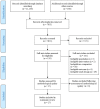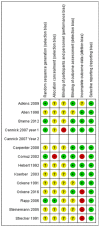The Effectiveness of Tobacco Dependence Education in Health Professional Students' Practice: A Systematic Review and Meta-Analysis of Randomized Controlled Trials
- PMID: 31661922
- PMCID: PMC6862178
- DOI: 10.3390/ijerph16214158
The Effectiveness of Tobacco Dependence Education in Health Professional Students' Practice: A Systematic Review and Meta-Analysis of Randomized Controlled Trials
Abstract
The objective of this study was to perform a systematic review to examine the effectiveness of tobacco dependence education versus usual or no tobacco dependence education on entry-level health professional student practice and client smoking cessation. Sixteen published databases, seven grey literature databases/websites, publishers' websites, books, and pertinent reference lists were searched. Studies from 16 health professional programs yielded 28 RCTs with data on 4343 healthcare students and 3122 patients. Two researchers independently assessed articles and abstracted data about student knowledge, self-efficacy, performance of tobacco cessation interventions, and patient smoking cessation. All forms of tobacco were included. We did not find separate interventions for different kinds of tobacco such as pipes or flavoured tobacco. We computed effect sizes using a random-effects model and applied meta-analytic procedures to 13 RCTs that provided data for meta-analysis. Students' counseling skills increased significantly following the 5As model (SMD = 1.03; 95% CI 0.07, 1.98; p < 0.00001, I2 94%; p = 0.04) or motivational interviewing approach (SMD = 0.90, 95% CI 0.59, 1.21; p = 0.68, I2 0%; p < 0.00001). With tobacco dependence counseling, 78 more patients per 1000 (than control) reported quitting at 6 months (OR 2.02; 95% CI 1.49, 2.74, I² = 0%, p = 0.76; p < 0.00001), although the strength of evidence was moderate or low. Student tobacco cessation counseling improved guided by the above models, active learning strategies, and practice with standardized patients.
Keywords: education; health professional students; randomized controlled trials; smoking cessation; systematic review; tobacco dependence intervention.
Conflict of interest statement
The authors declare no conflict of interest.
Figures








References
-
- Bilano V., Gilmour S., Moffiet T., D’Espaignet E.T., Stevens A., Commar A., Tuyl F., Hudson I., Shibuya K. Global trends and projections for tobacco use, 1990–2025: An analysis of smoking indicators from the WHO Comprehensive Information Systems for Tobacco Control. Lancet. 2015;385:966–976. doi: 10.1016/S0140-6736(15)60264-1. - DOI - PubMed
-
- World Health Organization and the Secretariat of the WHO Framework Convention on Tobacco Control . The Economic and Health Benefits of Tobacco Taxation [Online] WHO; Geneva, Switzerland: 2015. [(accessed on 29 September 2019)]. Available online: https://apps.who.int/iris/bitstream/handle/10665/179423/WHO_NMH_PND_15.6....
-
- Ellison L.F., Morrison H.I., De Groh M., Villeneuve P.J. Health consequences of smoking among Canadian smokers: An update. Chronic Dis. Can. 1999;20:36–39. - PubMed
Publication types
MeSH terms
LinkOut - more resources
Full Text Sources
Medical

